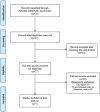Patterns of Teprotumumab-Induced Hearing Dysfunction: A Systematic Review
- PMID: 39194388
- PMCID: PMC12379858
- DOI: 10.1002/ohn.955
Patterns of Teprotumumab-Induced Hearing Dysfunction: A Systematic Review
Abstract
Objective: Hearing loss has been reported after administration of the monoclonal antibody teprotumumab. The purpose of this study was to review available evidence regarding the patterns of teprotumumab-related ototoxicity.
Data sources: PubMed, EMBASE, and Cochrane Library.
Review methods: A systematic review was performed using standardized methodology. Studies were included if they included subjects who were prescribed teprotumumab. Exclusion criteria included non-English articles, abstracts, letters/commentaries, case reports, and reviews. Subjects without both pre- and posttreatment audiometric data were also excluded. Bias was assessed using the Mixed Methods Appraisal Tool.
Results: From an initial search of 76 articles, 7 studies reporting on 109 unique patients were included. Four studies were level 4 evidence, 1 study was level 3 evidence, and 2 studies were level 2 evidence. Mean age was 55 ± 14 years with a female predominance (64%). The most commonly reported symptoms were hearing loss (22%), followed by fullness (18%) and tinnitus (14%). In total, 41% of patients with available data met criteria for ototoxicity, all exhibiting shifts in the middle frequencies or higher. Fifteen (14%) patients underwent ultrahigh frequency audiometric testing and 8 (53%, 8/15) demonstrated shifts exclusively in this range.
Conclusion: Ototoxicity may occur in patients treated with teprotumumab. Hearing loss occurs primarily in higher frequencies, and routine hearing screening with ultrahigh frequency testing may be warranted. The true incidence of ototoxicity with teprotumumab remains unknown, and more data is needed to elucidate underlying mechanisms and develop strategies to minimize risks.
Keywords: hearing loss; monoclonal antibody; ototoxicity; public health; sensorineural hearing loss; teprotumumab.
© 2024 The Author(s). Otolaryngology–Head and Neck Surgery published by Wiley Periodicals LLC on behalf of American Academy of Otolaryngology–Head and Neck Surgery Foundation.
Conflict of interest statement
None.
Figures
References
Publication types
MeSH terms
Substances
LinkOut - more resources
Full Text Sources
Miscellaneous


